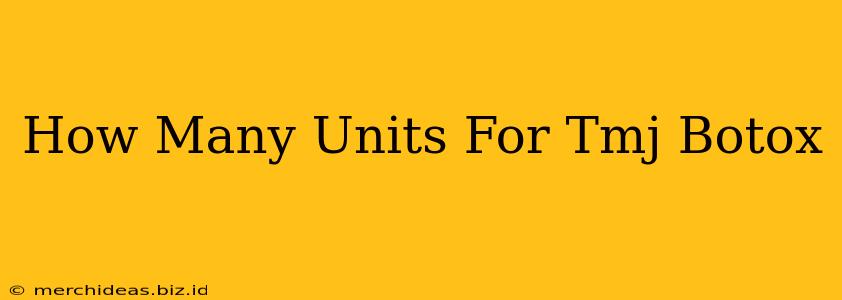Temporomandibular joint (TMJ) disorder is a prevalent condition causing jaw pain, headaches, and clicking. Botox injections have emerged as a popular treatment option, offering a less invasive alternative to surgery. But a crucial question remains: how many units of Botox for TMJ are needed? This isn't a simple answer, and this comprehensive guide will break down the factors influencing dosage.
Understanding Botox for TMJ Treatment
Botox, or botulinum toxin type A, works by temporarily paralyzing the muscles responsible for jaw clenching and grinding. By reducing muscle activity, it helps alleviate pain and improve function. However, the precise number of Botox units required varies significantly depending on several key factors.
Factors Determining Botox Unit Dosage for TMJ:
-
Severity of Symptoms: Individuals with mild symptoms may require fewer units than those experiencing severe pain and dysfunction. A thorough clinical evaluation is crucial to determine the appropriate dosage.
-
Muscle Size and Location: The size and location of the affected muscles influence the amount of Botox needed. Larger muscles generally require more units to achieve the desired effect. The masseter muscles (the main chewing muscles) are often targeted, and their size can vary substantially between individuals.
-
Patient's Response to Botox: Individual responses to Botox vary. Some patients may respond well to a lower dosage, while others might need more units for optimal results. This is often determined through trial and error.
-
Physician's Expertise: An experienced and qualified healthcare professional will accurately assess your condition and tailor the treatment plan accordingly, including the appropriate number of Botox units.
The Typical Range: How Many Units are Usually Used?
While there's no one-size-fits-all answer, many patients receiving Botox for TMJ treatment typically receive between 20 and 50 units per masseter muscle. This translates to a total of 40 to 100 units if both masseter muscles are treated, which is common. However, this is just a general range; some may need fewer, and others may need more.
It's crucial to remember that this is not a DIY treatment. Attempting to determine the correct dosage yourself is extremely dangerous and could lead to adverse effects.
What to Expect During and After Treatment
The Botox injection procedure itself is typically quick and minimally invasive. You may experience slight discomfort during the injection, similar to a pinprick.
After the treatment, you might experience some minor side effects, such as mild bruising, swelling, or headache. These side effects usually subside within a few days. The full effects of the Botox are generally seen within two to three weeks.
Important Note: The results of Botox for TMJ treatment are temporary, typically lasting around three to four months. Repeat treatments may be necessary to maintain relief from symptoms.
Choosing a Qualified Healthcare Provider
Selecting a qualified and experienced healthcare professional is paramount for safe and effective TMJ Botox treatment. Look for a doctor with expertise in treating TMJ disorders and experience administering Botox injections. Consultations are vital to discuss your specific needs and determine the appropriate course of treatment.
Don't hesitate to ask questions during your consultation about your specific situation and what to realistically expect from the procedure. Open communication is essential for achieving optimal results.
Keywords: TMJ Botox, Botox for TMJ, TMJ treatment, Botox units for TMJ, how much Botox for TMJ, masseter Botox, Botox dosage TMJ, TMJ pain relief, jaw pain treatment, Botox for jaw clenching, Botox for bruxism.
